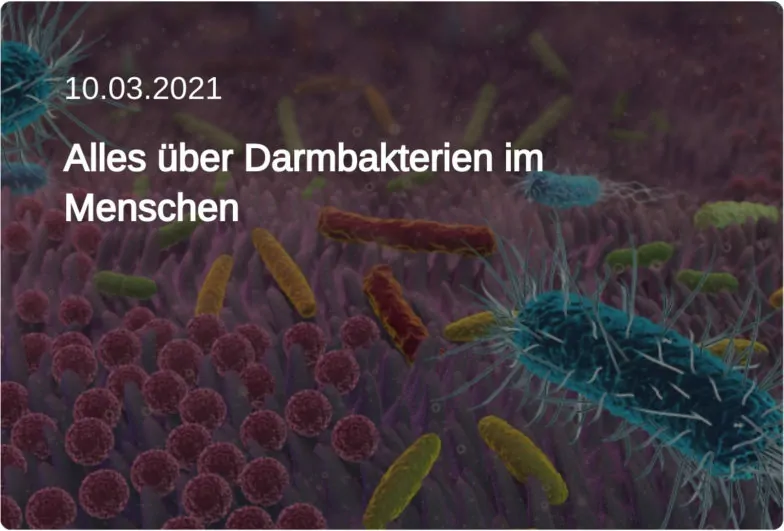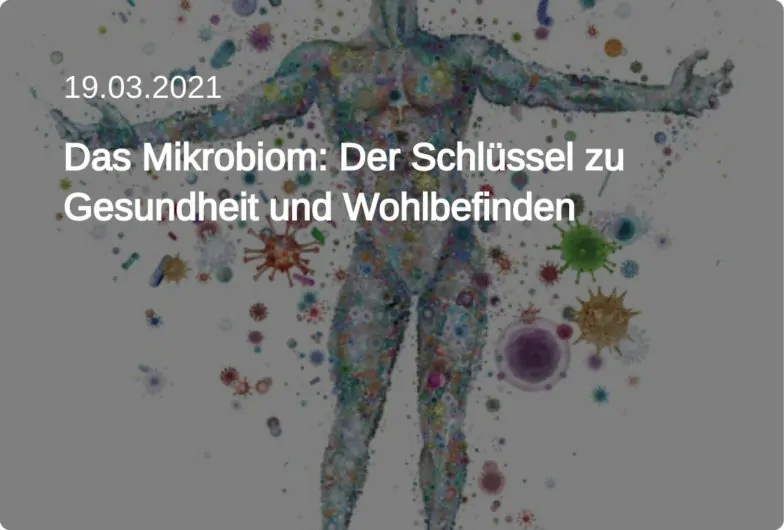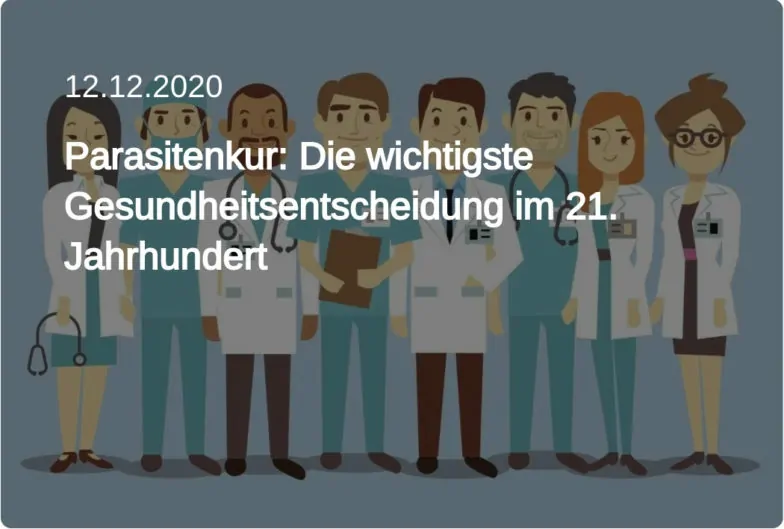Intestinal rehabilitation: in just 2 steps to a healthy intestine
Concrete step-by-step instructions for everyone to use at home
Dear reader,
In modern medicine, the intestine is the seat of health. [1] His condition determines, among other things, our feeling of happiness and the physical and mental well-being. [2]
Malnutrition, stress, taking medication and exposure to toxins causes intestinal volatility. [3]
A intestinal rehabilitation can restore the health of the intestine. [4]
This article tells you:
✅ Whether you really need a intestinal rehabilitation. You can use our free online medical history for this purpose.
✅ What you can expect from an intestinal rehabilitation and what not.
✅ How an intestinal rehabilitation exactly works. You will receive specific step-by-step instructions, which our experts free of charge created for you.
Before we start...
We recommend that you – before reading this article further – familiarize yourself with the topics of “intestinal bacteria” and “microbiome“. Now click on both tiles. A free specialist article on each of these topics will open for you:


Do you need an intestinal rehabilitation? Check it out now!
First of all, you should check whether therapy to cleanse the bowel is necessary. You can use our free online test for this. Now answer the following questions:
1 Do you feel tired even after getting enough sleep?
2 Do you have any allergies or food intolerances?
3 Do you have a bloated stomach or gas?
4 Do you often get sick and are you susceptible to infections?
5 Do you have a nutritional deficiency?
6 Do you regularly eat white flour products or ready meals?
7 Do you suffer from headaches or migraines?
8 Do you have food cravings?
9 Do you have a coating on your tongue in the morning?
10 Do you take pain medication regularly?
11 Do you suffer from itchy anus?
12 Do you feel full after eating?
13 Do you have mucus in your stool?
14 Do you have pimples or blemishes?
15 Are you suffering from mood swings for no apparent cause?
16 Are you overweight or underweight?
17 Have you ever had a yeast infection or candies?
18 Do you suffer from bad breath or gum disease?
19 Have you had to take antibiotics in the past 5 years?
20 Do you smoke or drink alcohol?
21 Do you have an itchy scalp or dandruff?
22 Do you consume more sugary and starchy foods?
23 Are you prone to dry or oily skin?
24 Are you prone to digestive problems, i.e. diarrhea, constipation or both?
25 Is your tongue coated and not pale pink?
26 Do you have frequent sweats?
This is what you can expect from an intestinal rehabilitation
Improving emotional health
The nervous system of the intestine is directly related to the brain. [5] So it is not surprising that the condition of the intestine has a direct influence on the emotional life.
✅ More happiness
The happiness hormone Serotonin is 90% formed in the intestine. [6] Accordingly, people with a healthy bowel feel significantly more high.
✅ Less negative feelings
A study published in the journal Microbiome also showed that people who suffer from intestinal colonization more fear and Feel other emotions rated as negative than people with a symbiotic colonization of their intestines. [7]
Improving physical health
Physical health also depends to a large extent on the condition of the intestines.
✅ Improved body defense
The intestine is the seat of the immune system. 80% of all immune cells in the body are located in this organ. [8]
✅ Less weight
Studies show a clear correlation between body weight and the intestinal environment. [9] Obesity is a factor in many diseases. [10] If you would like to find out more about how the wrong gut bacteria negatively affect our weight, click here:
✅ Healthy organs
With a study from 2016, French researchers showed that the intestine is connected to all other organs by the nervous system. The digestive tract has a direct influence on the function of all body organs. [11]
✅ Improved nutrient supply
Our Intestinal bacteria have the task to split the food. You also decide what is absorbed and what is excreted instead. Furthermore, they produce vital substances that our body cannot produce itself. [12]
✅ Regulated hormonal system
Hormones control our entire system. The hormones dopamine, serotonin and melatonin are synthesized in the intestine. [13] The organ also plays a major role in regulating the estrogen level. [14] A healthy microbiome reduces the likelihood of developing hormone-related diseases. [15]
✅ General health care
One in the specialist magazine Current Opinion in Gastroenterology published study showed that all health depends on the gut . [16] A connection to metabolic diseases such as type 2 diabetes has already been proven. [17] An unbalanced intestinal flora can also lead to autoimmune diseases [18] and cancer lead. [19]
Mental health improvement
Science now knows that in diseases of a mental origin the cause can often be found in the intestine. [20]
The reason for this is the so-called gut-brain axis. [21]
Excursus: gut-brain axis
This is a direct nerve connection between the digestive organs and the brain. The inhabitants of the intestine are constantly transmitting information to the brain. For example to create feeling hungry or appetite. When the intestine is sick, it has a direct impact on the brain. Among other things, mood, cognitive processes and sensitivity to stress can be massively affected by Microbiome to be influenced. [22]
✅ Depression and depressed mood
Scientists from Leuven in Belgium discovered in their research in 2019 that in people with Depression two strains of bacteria significantly reduced in the intestinal flora. These are the bacterial species of the genera Coprococcus and Dialister. [23]
So far it has not been possible to reproduce these bacteria outside the intestine. Therefore there are no probiotics with these types on the market. [24] Coprococcus and Dialister can, however, by a Intestinal rehabilitation be promoted. [25]
With this cause-oriented approach, even a severe depression can be cured. [26]
Excursus: The “gut feeling” scientifically examined
Prof. Dr. Peter Holzer from Austria was the first scientist to prove that the so-called “ gut feeling ” really does exist. The intestine sends messages that can be perceived by the brain. According to Dr. Holzer especially the health of ours Microbiomes widmen. [27]
✅ Attachments
The Microbiome plays a big role in the creation of Anxiety disorders. In a group of over 10,000 test persons, a one-time antibiotic treatment increased the risk of anxiety disorder by 1.17 – 1.44 times. [28]
This is because the Lactobacillus helveticus bacterial strain is being decimated. This regulates the feeling of fear. [29] Unfortunately, this bacterium cannot be supplied exogenously either. But about one Intestinal rehabilitation is it possible to strengthen that.
✅ eating disorder
In May 2019, the science magazine Spektrum reported that a eating disorder begins and that the Intestinal bacteria play a decisive role in this clinical picture. [30]
The mechanisms are different.
In anorexia, for example, the intestinal bacteria develop antibodies against certain molecules that regulate our appetite. [31]
In the case of overeating, on the other hand, this is the case Microbiome changed so that the hunger hormone ghrelin is increasingly formed. [32] There is a significantly larger appetite and thus often to obesity. [33]
For more information on how gut bacteria can cause obesity, see here.
Exactly which bacteria play a role in the eating disorder has not yet been clarified. However, scientists and doctors have been able to establish without a doubt that one Intestinal rehabilitation and a gut-friendly lifestyle can change the intestinal environment in a way that eating disorders can be cured. [34]
Excursus: Getting out of the eating disorder
Why it becomes more and more difficult to get out of an eating disorder over time, Dr. Cynthia Bulik and her team figured out. The reason is that the microbial diversity continues to decrease in the course of the disease due to malnutrition . In the case of anorexia nervosa, only the anorexia remain Bacteria in the gut, who feel comfortable in a nutrient- and energy-poor environment. [35]
The advantages of an intestinal rehabilitation at a glance:
- More energy
- More well-being
- Seldom sick
- Protection against physical and mental illness
- Better mood
- The way to ideal weight
- Mentally stable
- Improved cognitive performance
- Improving intuition
- More happiness
- Better sleep
- Better nutrient supply
Colon rehabilitation: the step-by-step guide
The basics
The aim of intestinal rehabilitation (sanare = heal, restore) is to harmonize the Microbiome in the gut. [36]
Understanding how to do this requires you the microbiome to understand:
This is because it consists of three different types of microbes: (37)
✅ Commensal organisms: live with us – without influencing us
✅ Symbiotic organisms: heroes of our health – without negative impact
✅ Parasitic Organisms: direct exclusively damage – without positive influence
The goal of intestinal rehabilitation is: [38]
✅ The reduction of parasitic organisms
✅ The promotion of symbiotic organisms
The chronological order: [39]
✅ First the parasitic microbes in the intestine must be regulated. Support for symbiotic organisms is only possible in this case. Learn more
✅ Next, the symbiotic microbes are promoted. As I said, this is only possible if the parasitic organisms in the intestine have been reduced beforehand.
Step 1: regulation of the parasitic organisms
This step should be carried out over a period of 6 weeks.
Definition „Parasit“
Parasitic; A living being that derives unilaterally benefit from living together with another living being (host), feeds on the host, attacks it for reproductive purposes, damages the host and causes diseases by impairing organ functions, destroying cells and deprives it of nutrients. [40]
Based on the definition, the parasitic microbes can now be divided as follows:
✅ Intestinal parasites
This includes worms, leeches and also parasitic unicellular cells. Many people think that they are not affected by these pathogenic life forms. But they are wrong. Almost all humans have, in addition to other microbes (e.g. bacteria), parasites in their intestines. More on this
Important!
Intestinal parasites promote the spread of “bad” intestinal bacteria, pathogenic fungi and yeasts as well as the development of the biofilm. This makes them the most serious factor in a disturbed microbiome. More information about this
To find out whether and which parasites you are infected with, first do our free online parasite test:
✅ „Poor“ Intestinal bacteria
These also live parasitically in the human intestine. That is, they do only harm. Accordingly, they should be decimated to the maximum. You can learn everything about intestinal bacteria here read up.
✅ Pathogenic fungi and yeasts
Parasitic intestinal fungi, like Candida albicans in its pathogenic form should also be removed.
✅ Biofilm in the intestine
There is still no scientific consensus on whether the Biofilm can be classified as a parasitic creature. From a purely morphological point of view, one should certainly count him among them. more on this
But even if you don’t do that, it supports at least all parasitic organisms in the intestine. He gives them protection and supports them in growth. more on this
Attention!
The biofilm must be removed from the intestine in phase 1, otherwise the decimation of the parasitic organisms is not possible and phase 2 cannot be carried out successfully either.
A so-called “Parasite Cure” is used to regulate parasitic organisms in the intestine.
If this is holistic designed, it can cause intestinal parasites as well as pathogenic bacteria, yeast and fungi and the biofilm from the intestine.
We provide you with a guide on how a parasite cure works free of charge. Now click on this tile:

Warning!
If you want to rehabilitate your intestines, then don’t fast. It damages the microbiome heavily. Incidentally, bowel emptying or colon cleansing is of no use.
Step 2: promoting the symbiotic organisms
The aim of the second step is to restore the microorganisms living in symbiosis with us in diversity, abundance, communication and activity.
This step should be implemented over a period of at least 3 months.
Attention!
We strongly advise against taking probiotics. More on this
Instead of the senseless intake of preparations with probiotic bacterial cultures, the following measures are induced:
✅ Adjustment of the diet (nutrition plan)
- Feeding fresh food if possible (freshly picked lettuce, home-grown sprouts, cress, chives, etc.).
- Food in a as large as possible variability So if possible, eat as much as possible.
- At most a moderate intake of fats. Pay attention to enough omega-3 fats (e.g. from linseed, chia seeds, salmon from clean water, etc.).
- Avoid food treated with pesticides as much as possible.
- Fermented foods (e.g. sauerkraut, kimchi or tempeh) should be on the menu regularly. They are the real (and effective) probiotic.
- Sugar delete as best you can from the menu. Instead you should use xylitol. It sweetens like sugar and also counteracts harmful intestinal bacteria.
- Eat a lot of good fiber from vegetables, fruits and grains.
- Take quiet time to eat and chew your food thoroughly.
- Drink a lot. At least 2 liters of pure water a day.
Ein kostenfreies E-Book mit leckeren Rezepten für einen gesunden Darm können Sie hier herunterladen:
Install OPT IN e-Book „Gut-friendly recipes“
✅ Lifestyle adjustment
- Movement gets the microbiome going. Yoga, endurance training, running or even just a walk should be done regularly.
- Avoid pleasure poisons such as nicotine and alcohol as much as possible.
✅ Dietary supplement
- The only addition to your food that you should really use for intestinal cleansing is EM-1 – “effective microorganisms“.
- These are not purely probiotic bacteria, but diverse microbes that are composed in such a way that they can have a fundamentally positive effect on the intestinal flora.
- Always use the original EM-1 and not EMa, which have no positive influence on the microbiome.
- Ingestion:
- Daily
- With a meal or in water
- Start with three drops three times a day
- From day 4, daily increase by one drop
- The slow increase is important for tolerability
- Maximum amount 1 tbsp per serving
FAQ: Questions and answers on the subject of "intestinal rehabilitation"
Colon cleansing is the cleansing of the intestines with the help of enemas or laxatives. It usually serves as preparation for medical interventions. It is not necessary for intestinal rehabilitation.
The aim of intestinal rehabilitation is to harmonize the intestinal microbiome.
An intestinal rehabilitation is a mild and beneficial procedure to bring the intestine and the entire organism into balance. That is why there are usually no side effects.
However, the demise of the parasitic organisms can trigger detoxification reactions. This can be expressed as follows:
- Flatulence
- itching
- headache
- stomach pain
- Hives
- dry mouth
- nausea
- blemished skin
- diarrhea
No, this is not possible. That Microbiome is a dynamic and complex process. You have to understand it and take appropriate action. There is no preparation that is suitable for intestinal rehabilitation. Read here everything about how an intestinal rehabilitation works.
Vita Biosa can at most have a supportive effect, but cannot replace an intestinal rehabilitation. You will find out how intestinal rehabilitation works here.
Yes, that is possible. You can find the instructions for intestinal rehabilitation here.
A rehabilitation of the intestine with these products is not possible. That Microbiome is a dynamic and complex process. You have to understand it and take appropriate action. There is no preparation that is suitable for intestinal rehabilitation. Read here everything about how an intestinal rehabilitation works.
We strongly advise against using this product.
The powder sold contains maltodextrin as the first ingredient. It is a mixture of carbohydrates made from corn starch. Maltodextrin is broken down into glucose in the body and thus causes the blood sugar level to rise. The second ingredient is oligofructose, which is a multiple sugar.
Sugar and starch are not only of no use for a healthy intestinal flora, but also promote “bad” bacteria, intestinal parasites as well as pathogenic yeasts and fungi. How an intestinal rehabilitation really works can be found here.
A bowel rehabilitation can have a soothing effect on histamine intolerance. Histamine-containing foods should of course be avoided in the rehabilitation. You can find step-by-step instructions for intestinal rehabilitation here.
No. There is no such drug on the market. To find out how an intestinal rehabilitation works, click here.
Many strains of the microbial species have not yet been discovered at all, and those known, such as the Firmicutes and the Bacteroidetes, which are very important for digestion, cannot be successfully grown outside the body. Thus, the intake is as good as ineffective.
Even fewer bacteria can survive as capsules or powders long enough to be of real use. Probiotics are not a means of intestinal cleansing and can at most contribute a little to the restoration of the microbial balance.
Ingested bacteria usually do not settle in the body like a seed, but rather only give impulses.
As long as there is an excess of parasitic organisms, they will eat the supplied positive bacteria anyway.
You can find out how an intestinal rehabilitation really works here.
Fortakehl is just a homeopathic medicine which is mainly used for stomach pain. It is not an intestinal rehabilitation. You can find out how this works here.
MSM can be taken as a support in the context of intestinal rehabilitation. Used alone, however, it is by far not enough to rehabilitate the intestines. You can find out how this works here.
There are no home remedies for intestinal cleansing. The microbiome is a dynamic and complex process. You have to understand it and take appropriate action. Read here everything about how an intestinal rehabilitation works.
Oregano oil acts as a natural antibiotic. The oil has an antibacterial, antiviral and fungicidal effect. It can help kill pathogens in the digestive tract. However, oregano oil cannot replace intestinal rehabilitation. You can find out how the intestinal rehabilitation works here.
Healing earth (or bentonite, zeolite) cannot help cleanse the intestines, but it can bind released toxins. In this way, possible side effects can be reduced.
Many strains of the microbial species have not yet been discovered at all, and those known, such as the Firmicutes and the Bacteroidetes, which are very important for digestion, cannot be successfully grown outside the body. Thus, the intake is as good as ineffective.
Even fewer bacteria can survive as capsules or powders long enough to be of real use. Probiotics are not a means of intestinal cleansing and can at most contribute a little to the restoration of the microbial balance.
Ingested bacteria usually do not settle in the body like a seed, but rather only give impulses.
As long as there is an excess of parasitic organisms, they will eat the supplied positive bacteria anyway.
How an intestinal rehabilitation really works can be found here.
Linseed oil is said to have anti-inflammatory properties due to its high content of alpha-linoleic acids (omega 3). This is positive, but has nothing to do with an intestinal rehabilitation. Too many fats should be avoided in an intestinal rehabilitation. This also applies to linseed oil. More on this
Inulin is said to have a prebiotic effect. It feeds good intestinal bacteria and can therefore support a healthy intestinal flora. It can be done as part of step 2 our intestinal rehabilitation be taken.
Many strains of the microbial species have not yet been discovered at all, and those known, such as the Firmicutes and the Bacteroidetes, which are very important for digestion, cannot be successfully grown outside the body. Thus, the intake is as good as ineffective.
Even fewer bacteria can survive as capsules or powders long enough to be of real use. Probiotics are not a means of intestinal cleansing and can at most contribute a little to the restoration of the microbial balance.
Ingested bacteria usually do not settle in the body like a seed, but rather only give impulses.
As long as there is an excess of parasitic organisms, they will eat the supplied positive bacteria anyway.
How an intestinal rehabilitation really works can be found here.
A bowel rehabilitation can have positive effects on the skin’s appearance. A bad intestinal environment often manifests itself in the form of blemished skin.
You can find out how an intestinal rehabilitation works here.

